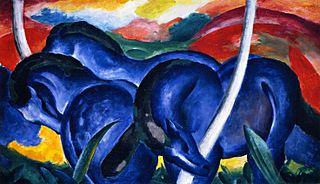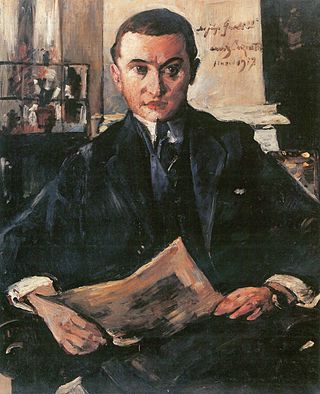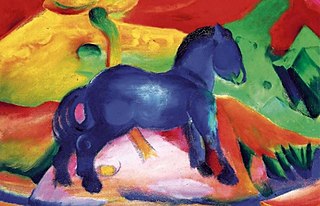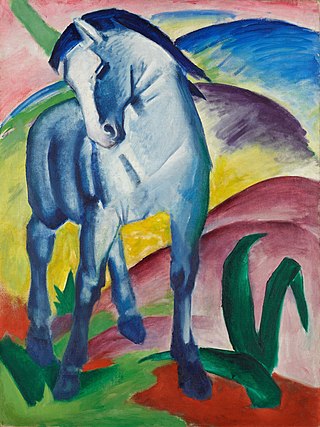
Wassily Wassilyevich Kandinsky was a Russian painter and art theorist. Kandinsky is generally credited as one of the pioneers of abstraction in western art. Born in Moscow, he spent his childhood in Odessa, where he graduated from Odessa Art School. He enrolled at the University of Moscow, studying law and economics. Successful in his profession, he was offered a professorship at the University of Dorpat. Kandinsky began painting studies at the age of 30.

Franz Moritz Wilhelm Marc was a German painter and printmaker, one of the key figures of German Expressionism. He was a founding member of Der Blaue Reiter, a journal whose name later became synonymous with the circle of artists collaborating in it.

Otto Müller was a German painter and printmaker of the Die Brücke expressionist movement.

Blue Horses is a 1911 painting by German painter and printmaker Franz Marc (1880–1916).

Wolfgang Gurlitt was a German art dealer, museum director and publisher whose art collection included Nazi-looted art.

The Bavarian State Painting Collections, based in Munich, Germany, oversees artwork held by the Free State of Bavaria. It was established in 1799 as Centralgemäldegaleriedirektion. Artwork includes paintings, sculptures, photographs, video art and installation art. Pieces are on display in numerous galleries and museums throughout Bavaria.
Rudolf Bredow, German post-expressionist painter, draughtsman and art teacher.

Otto Müller was a German painter and graphic designer.

The Degenerate Art exhibition was an art exhibition organized by Adolf Ziegler and the Nazi Party in Munich from 19 July to 30 November 1937. The exhibition presented 650 works of art, confiscated from German museums, and was staged in counterpoint to the concurrent Great German Art Exhibition. The day before the exhibition started, Adolf Hitler delivered a speech declaring "merciless war" on cultural disintegration, attacking "chatterboxes, dilettantes and art swindlers". Degenerate art was defined as works that "insult German feeling, or destroy or confuse natural form or simply reveal an absence of adequate manual and artistic skill". One million people attended the exhibition in its first six weeks. A U.S. critic commented that "[t]here are probably plenty of people—art lovers—in Boston, who will side with Hitler in this particular purge". This view was controversial, however, given the greater political context of the exhibition.

The Tower of Blue Horses is a 1913 oil painting by the German Expressionist artist Franz Marc. It has been called one of his best works, but went missing in 1945.

Hildebrand Gurlitt was a German art historian and art gallery director who dealt in Nazi-looted art as one of Hitler's and Goering's four authorized dealers for "degenerate art".

The Gurlitt Collection was a collection of around 1,500 art works inherited by Cornelius Gurlitt, the son of one of Hitler's official art dealers, Hildebrand Gurlitt (1895–1956), and which was found to have contained several artworks looted from Jews by the Nazis.
Meike Hoffmann is a German art historian and provenance researcher.

Rolf Nikolaus Cornelius Gurlitt was a German art collection owner. The son of Hildebrand Gurlitt, an art gallery director and Nazi-era dealer of looted art, Gurlitt inherited from his father a collection of over 1,400 artworks known as the Gurlitt trove or Gurlitt Collection, a small number of which were subsequently demonstrated to have been looted from Jews by Nazis. Upon its public discovery, the collection was impounded by the Augsburg Prosecutor's Office as evidence in a possible case for tax evasion that was never mounted; the works were not returned to Gurlitt's estate until after his death. In his will, Gurlitt left the entire collection, minus any works that turned out to be looted, to a lesser known gallery in Switzerland, the Museum of Fine Arts Bern, apparently in reaction over his perceived poor treatment by the German authorities.

Yellow Cow is a painting by the German artist Franz Marc, dating to 1911. It is one of the artist's most well known works, and is one of several of his depictions of animals in Expressionist style. This work is oil on canvas and measures 140.5 x 189.2 centimeters. The central motif of the painting is a jumping cow, surrounded by a colorful, structured landscape. The painting is characterized by the contrast between the dynamic central motif and the calm background.

Little Blue Horse is an oil on canvas painting by German Expressionist painter Franz Marc, from 1912.

Hermann Voss was a German art historian and museum director appointed by Hitler to acquire art, much of it looted by Nazis, for Hitler's planned Führermuseum in Linz, Austria.

Blue Horse I is an oil painting by Franz Marc completed in 1911. It is one of the painter's most famous works and is part of the collection of the Städtische Galerie im Lenbachhaus in Munich. The painting was part of several exhibitions that Franz Marc and fellow Russian painter Wassily Kandinsky presented to the public under the name Der Blaue Reiter from late 1911 until 1914.

In 1939 the Gallery Fischer in Lucerne organized an auction of degenerate art confiscated by the Nazis. The auction took place on 30 June 1939 in the Grand Hotel National. The auction received considerable international interest, but many of the bidders who were expected to attend were absent because they were worried the proceeds would be used by the Nazi regime.

Swamp Legend ("Sumpflegende") is an oil-on-cardboard painting by Swiss German painter Paul Klee, from 1919. It has been in the Städtische Galerie im Lenbachhaus, in Munich, since 1982, but its ownership was disputed due to its provenance. The painting was one of the works considered by the National Socialists as “degenerate art” and was confiscated from the Landesmuseum Hannover, in Hanover, in 1937. However, it was not owned by the museum, but was there on a loan from the art historian Sophie Lissitzky-Küppers. In July 2017 it became known that her heirs had reached an agreement with the city of Munich abouts its ownership.


















